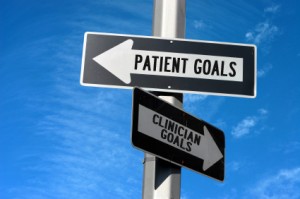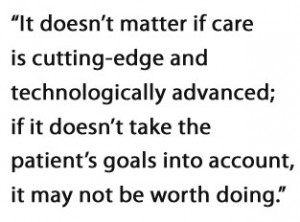For those of you who haven’t yet heard, I have recently been diagnosed with Stage IV inflammatory breast cancer. This rare form of breast cancer is known for its rapid spread. True to form, it has metastasized to my spine. This means my time is limited. As a nurse, I knew it from the moment I saw a reddened spot on my breast and recognized it for what it was.
My recent journey through the health care system has been eye-opening. In only a few months, I have witnessed the remarkable capabilities and the stunning shortcomings of our health care system firsthand. I am writing here because in the time I have left, I hope my story and my journey can help illustrate why some of the reforms that my colleagues and I at the John A. Hartford Foundation, as well as many others, have championed are so important.
 © iStockphoto.com/belterz
© iStockphoto.com/belterzAt the cancer’s earliest appearance, I consulted with a well-regarded oncologist in New York. After the tests were done she regretfully informed me that my disease was not curable. Because my cancer is hormone-receptor-positive, she recommended an evidence-based course of medications aimed at slowing the progression of the disease. Before I committed to this course of care, I wanted to get a second opinion. I secured an appointment with the pre-eminent researcher/clinician in the field of inflammatory breast cancer, at a top medical institution in Philadelphia.
The building was beautiful, the staff attentive. They even assigned a nurse, whom they assured would follow me throughout my course of care. I had no doubt that the care would be top-notch.
Everything changed when my mother and I sat down with the physician. He never asked about my goals for care. He recommended an aggressive approach of chemotherapy, radiation, mastectomy, and more aggressive chemotherapy. My doctor back in New York had said this was the standard, evidence-based protocol for patients in Stage IIIB, whose cancer had only spread locally. But since I am in Stage IV she said I wouldn’t get the benefit of this aggressive, curative approach.
“All of my patients use this protocol,” he said.
I was shocked. “Does this mean I could get better?” I asked.
“No, this is not a cure.” he answered. “But if you respond to the treatment, you might live longer, although there are no guarantees.”
My goals are to maximize my quality of life so I can live, work, and enjoy my family with the least pain and the most function. Would I undergo a year or more of grueling, debilitating treatment only to live with spinal fractures if the cancer progressed? Would the treatment strip me of the quality of life I enjoy now? I wouldn’t be cured by the treatment. Would I get the possibility of quantity and no quality?
I pressed him. “Why do the mastectomy?” I asked, puzzled. “The cancer has already spread to my spine. You can’t remove it.”
His brow furrowed. “Well, you don’t want to look at the cancer, do you?”
He made it sound like cosmetic surgery. Considering that a total mastectomy includes months of pain and rehabilitation, I thought that worrying about the view was secondary. Right now, I feel fine. I can work. I am pain free. Did I want to trade that for a slim chance of a little extra time (no guarantees, of course)? Would they be years of living, or years of suffering?
“But what about the side effects of radiation?” I asked. “I’ve heard they are terrible.”
He frowned and seemed annoyed by my questions. “My patients don’t complain to me about it,” he replied.
 Inwardly, I shook my head. Of course his patients never complained to him. Most of them were probably unaware that other, less aggressive treatments were viable options for patients with this stage of disease. To me, there were real drawbacks. Undergo aggressive therapy that might buy me a longer life…at what cost? I might never recover my health for the limited period of time I might have following the aggressive treatment. This doctor, top in his field, was reflecting the bias of our medical system towards focusing only on survival. He was focused only on quantity and forgot about quality. The patient’s goals and desires, hopes and fears, were not part of the equation. He was practicing one-size-fits-all medicine that was not going to be right for me, even though scientific studies showed it was statistically more likely to lengthen life. His lack of concern for my focus on quality versus quantity of life reminded me of how so many older Americans are treated at the end of life, shuttled in and out of hospitals and hooked up to countless machines to keep them alive when all they want is to manage pain and symptoms and to spend their final days at home, with their loved ones.
Inwardly, I shook my head. Of course his patients never complained to him. Most of them were probably unaware that other, less aggressive treatments were viable options for patients with this stage of disease. To me, there were real drawbacks. Undergo aggressive therapy that might buy me a longer life…at what cost? I might never recover my health for the limited period of time I might have following the aggressive treatment. This doctor, top in his field, was reflecting the bias of our medical system towards focusing only on survival. He was focused only on quantity and forgot about quality. The patient’s goals and desires, hopes and fears, were not part of the equation. He was practicing one-size-fits-all medicine that was not going to be right for me, even though scientific studies showed it was statistically more likely to lengthen life. His lack of concern for my focus on quality versus quantity of life reminded me of how so many older Americans are treated at the end of life, shuttled in and out of hospitals and hooked up to countless machines to keep them alive when all they want is to manage pain and symptoms and to spend their final days at home, with their loved ones.
Based on a perverse set of metrics, the Philadelphia oncologist was offering technically the “best” care America had to offer. Yet this good care was not best for me. It wouldn’t give me health. Instead, it might take away what health I had. It doesn’t matter if care is cutting-edge and technologically advanced; if it doesn’t take the patient’s goals into account, it may not be worth doing.
 I returned to my original oncologist. I was determined not only to choose treatment that would maximize the healthy time I had remaining, but also to use that time to call on our health care institutions and professionals to make a real commitment to listening to their patients. In the health policy field, we call this patient-centered care. As a nurse and a senior program officer at a health care foundation, I understood my disease and my health care options well enough to make an informed decision about my treatment.
I returned to my original oncologist. I was determined not only to choose treatment that would maximize the healthy time I had remaining, but also to use that time to call on our health care institutions and professionals to make a real commitment to listening to their patients. In the health policy field, we call this patient-centered care. As a nurse and a senior program officer at a health care foundation, I understood my disease and my health care options well enough to make an informed decision about my treatment.
What about the millions of older Americans facing a terminal illness or chronic disease? How can they possibly stand up to the juggernaut of our health system and say, “No. I want care that focuses on my goals, care that is centered on me.” We need to make it easier for everyone to obtain care that fits their health care goals. How can we change the system and the measurement of quality to place the patient at the center? I call on everyone involved in health care practice and reform efforts to give serious thought about how we can reorient our health care system toward patient-centered care.
First in a series. See also:
"Death Panels and Decision-Making: A Radio Interview"
"Making Hard Decisions Easier"
